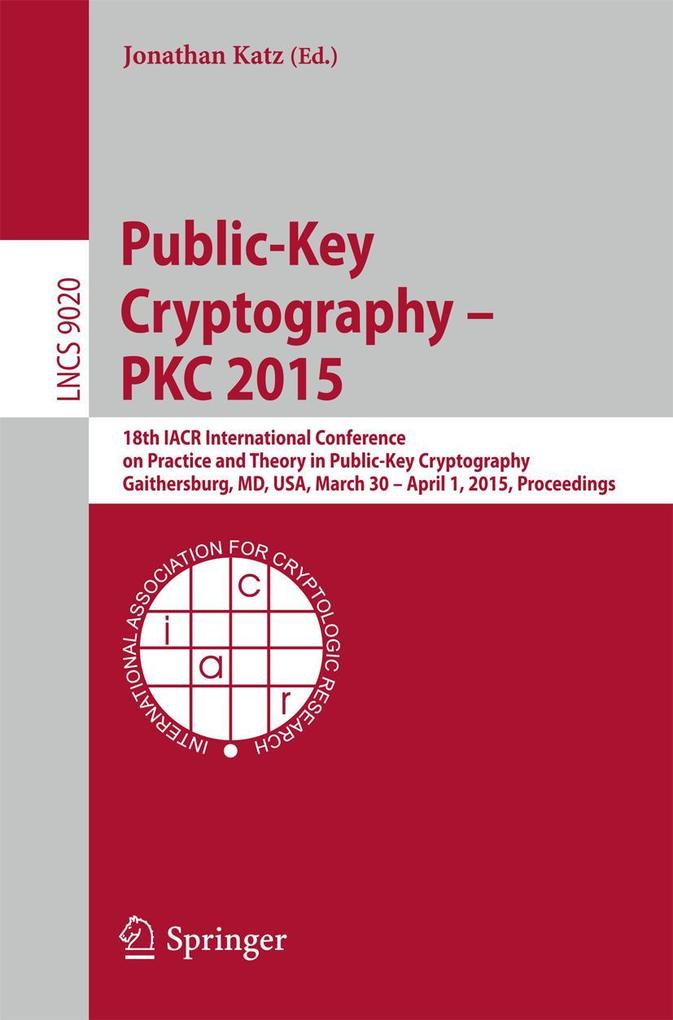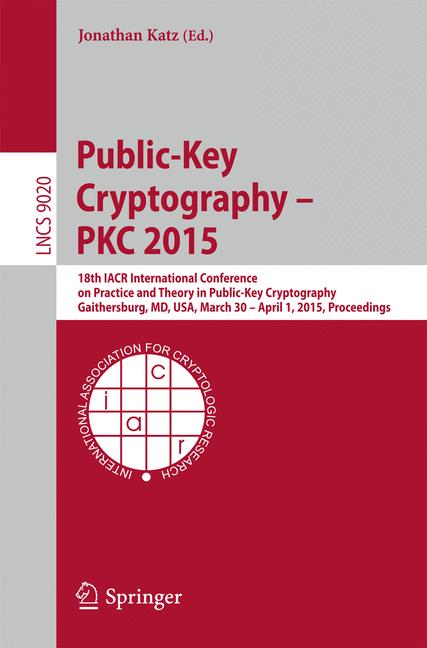Bücher versandkostenfrei*100 Tage RückgaberechtAbholung in der Wunschfiliale
10% Rabatt10 auf Toniebox 1, Figuren & Zubehör mit dem Gutscheincode: TONIE10
Jetzt einlösen
mehr erfahren
Zustellung: Do, 18.09. - Sa, 20.09.
Versand in 2 Tagen
VersandkostenfreiBestellen & in Filiale abholen:
This book constitutes the refereed proceedings of the 18th International Conference on Practice and Theory in Public-Key Cryptography, PKC 2015, held in Gaithersburg, MD, USA, in March/April 2015. The 36 papers presented in this volume were carefully reviewed and selected from 118 submissions. They are organized in topical sections named: public-key encryption; e-cash; cryptanalysis; digital signatures; password-based authentication; pairint-based cryptography; efficient constructions; cryptography with imperfect keys; interactive proofs; lattice-based cryptography; and identity-based, predicate, and functional encryption.
Inhaltsverzeichnis
Public-Key Encryption. - Simulation-Based Selective Opening CCA Security for PKE from Key Encapsulation Mechanisms. - On the Selective Opening Security of Practical Public-Key Encryption Schemes. - How Secure is Deterministic Encryption? . - E-Cash. - Divisible E-Cash Made Practical. - Anonymous Transferable E-Cash. - Cryptanalysis. - Collision of Random Walks and a Refined Analysis of Attacks on the Discrete Logarithm Problem. - A Polynomial-Time Key-Recovery Attack on MQQ Cryptosystems. - A Polynomial-Time Attack on the BBCRS Scheme. - Algebraic Cryptanalysis of a Quantum Money Scheme: The Noise-Free Case. - Digital Signatures. - Digital Signatures from Strong RSA without Prime Generation. - Short Signatures with Short Public Keys from Homomorphic Trapdoor Functions. - Tightly-Secure Signatures from Chameleon Hash Functions. - Password-Based Authentication. - Two-Server Password-Authenticated Secret Sharing UC-Secure Against Transient Corruptions. - Adaptive Witness Encryption and Asymmetric Password-Based Cryptography. - Public-Key Encryption Indistinguishable Under Plaintext-Checkable Attacks. - Pairing-Based Cryptography. - Strongly-Optimal Structure Preserving Signatures from Type II Pairings: Synthesis and Lower Bounds. - A Profitable Sub-prime Loan: Obtaining the Advantages of Composite Order in Prime-Order Bilinear Groups. - Digital Signatures. - Simpler Efficient Group Signatures from Lattices. - Group Signatures from Lattices: Simpler, Tighter, Shorter, Ring-Based. - Secure Efficient History-Hiding Append-Only Signatures in the Standard Model. - Efficient Constructions. - One-Round Key Exchange with Strong Security: An Efficient and Generic Construction in the Standard Model. - Additively Homomorphic UC Commitments with Optimal Amortized Overhead. - Interactive Message-Locked Encryption and Secure Deduplication. - Faster ECC over F2521_1. - Cryptography with Imperfect Keys. - Continuous Non-malleable Key Derivation and Its Application to Related-Key Security. - A Tamper and Leakage Resilient von Neumann Architecture. - Low Noise LPN: KDM Secure Public Key Encryption and Sample Amplification. - Interactive Proofs. - Adaptive Proofs of Knowledge in the Random Oracle Model. - Making Sigma-Protocols Non-interactive Without Random Oracles. - Lattice-Based Cryptography. - Bootstrapping BGV Ciphertexts with a Wider Choice of p and q. - Packing Messages and Optimizing Bootstrapping in GSW-FHE. - Simple Lattice Trapdoor Sampling from a Broad Class of Distributions. - Identity-Based, Predicate, and Functional Encryption Simple Functional Encryption Schemes for Inner Products. - Predicate Encryption for Multi-Dimensional Range Queries from Lattices. - On the Practical Security of Inner Product Functional Encryption. - Identity-Based Encryption with (almost) Tight Security in the Multi-instance, Multi-ciphertext Setting.
Produktdetails
Erscheinungsdatum
19. März 2015
Sprache
englisch
Auflage
2015
Seitenanzahl
840
Reihe
Security and Cryptology
Herausgegeben von
Jonathan Katz
Illustrationen
XIV, 824 p. 123 illus.
Verlag/Hersteller
Produktart
kartoniert
Abbildungen
XIV, 824 p. 123 illus.
Gewicht
1247 g
Größe (L/B/H)
235/155/45 mm
ISBN
9783662464465
Entdecken Sie mehr
Bewertungen
0 Bewertungen
Es wurden noch keine Bewertungen abgegeben. Schreiben Sie die erste Bewertung zu "Public-Key Cryptography -- PKC 2015" und helfen Sie damit anderen bei der Kaufentscheidung.










